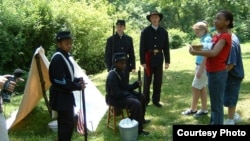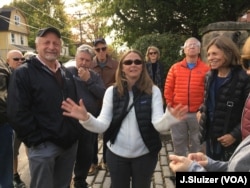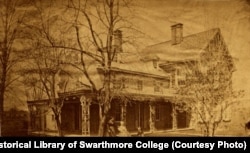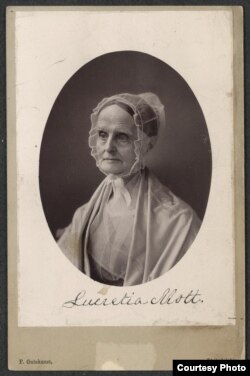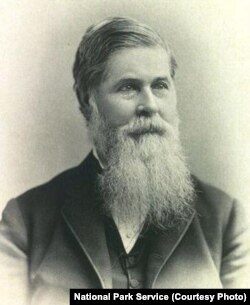You may not have heard of Cheltenham, Pennsylvania, but it played a surprisingly large role in U.S. history. And surprisingly, says teacher Lise Marlowe, even people who spent their entire lives in the community knew nothing about the area’s rich legacy.
Including her.
“Never heard of Camp William Penn, never heard of African-American soldiers training here. I never heard that Lucretia Mott was this famous abolitionist lady who lived here. I wasn’t taught that Frederick Douglas was here. That Harriet Tubman was here. And here I am teaching social studies!”
Hands-on history
To introduce her students to the Civil War history right beneath their feet, Marlowe worked with them to write a book called, ‘Back in Time With Cheltenham.’ The sixth-graders also made a movie with the same name.
Without Marlowe’s knowledge, the book and documentary were submitted to the History Channel’s first ‘Teacher of the Year’ contest in 2006 and, out of thousands of entries, she won.
The prize was a trip to the White House and $5,000, which she spent for her class.
“The first thing I did was buy re-enactment Civil War costumes, so that my students, when we do Black History month at La Mott Center every year, we now have some legit costumes,” Marlowe said.
High school reunion history tour
Celebrating her 50th birthday this year, Marlowe was the perfect person to give members of Cheltenham High School’s class of 1967 – home for their 50th reunion – a local history tour.
She starts with Richard Wall, Cheltenham’s first settler. In search of religious freedom, he left Cheltenham, England, with other Quakers in 1682, for the American colony of Pennsylvania. Wall called the area around their new settlement Cheltenham, after the town they’d left behind. Marlowe says his home soon became a Quaker meetinghouse.
“The coolest thing about the Wall House is that it’s one of the very first places in the nation where they talked about ending slavery,” she marvels. “In 1688!”
Marlowe’s tour also touches on local Revolutionary War history. George Washington moved his troops through Cheltenham many times, with his Continental Army often hiding in the woods to escape the thousands of British soldiers hunting them.
Civil War hotspot
Then, she comes to what is clearly her favorite part of Cheltenham history: the Civil War era. “This is the first time in our nation, our nation, that African-Americans were U.S. soldiers – first time.”
Because Philadelphia had a large African-American population, it made sense that regiments of black soldiers would be trained in the city to join the Union army. But, because of family, marriage and business ties, Philadelphia had many Southern state sympathizers and city officials were afraid there would be riots.
“They wanted to move it outside of Philadelphia,” Marlowe explains to the crowd. “So, who’s that? That’s us. Right? Cheltenham Avenue. Right? It’s the border of Philadelphia and Cheltenham. So, all that land on the other side of Cheltenham Avenue was Lucretia Mott’s land. Now we know she was a Quaker, very against war, but she understood why black men wanted to fight and end slavery. And that’s why she leased the land to the government for $1.”
Lucretia Mott
Lucretia Mott found slavery abhorrent and devoted her life to its abolition. She and her merchant husband, James, refused to buy, use or sell anything made or grown with slave labor. Their home was open to fugitives, running from Southern slave states to freedom in Canada.
William Still, known as ‘Father of the Underground Railroad,’ was a frequent visitor to the Mott home. As was conductor Harriet Tubman, who guided several hundred slaves to freedom.
Mott was also a strong advocate for women’s equality and is said to have launched the Suffragette movement with an infamous document, co-written with Elizabeth Cady Stanton. The ‘Declaration of Sentiments,’ revised the Declaration of Independence to include language giving rights to women.
Marlowe calls Mott the most important woman of the 19th century.
“She wasn’t just an amazing abolitionist. She was an incredible woman’s suffragist," she said. "She spoke all over the world. I don’t know how she did it. She was just incredible.’
Camp William Penn was built on Lucretia Mott’s leased land, and 11,000 men – nearly half former slaves – trained there. Marlowe says they served honorably.
“They were sent to find Abraham Lincoln’s assassins. They were at the surrender of Lee in Virginia. They were the only black troops to carry Lincoln’s casket when he was killed,." she said. "And, when you read a Civil War book – could be 2,000 pages long – there’s no mention of them. They were 12 percent of the army. Twelve percent of the Union army! No mention of them.”
When the war was over, Camp William Penn was torn down and the wood used to build houses in the part of Cheltenham now called La Mott – after Lucretia Mott.
Financier of the Civil War
America’s first investment banker, Jay Cooke, built his mansion in Cheltenham, before the Civil War, not far from Camp William Penn and his good friend, Lucretia Mott. Cooke called his home ‘Ogontz,’ after a Native American Indian chief who had been his childhood friend and mentor in Sandusky, Ohio, where he'd grown up in a radical anti-slavery family. On January 1, 1861, a few months before the start of the Civil War, Cooke opened a private banking house in Philadelphia. It was the first firm to have an in-house telegraph system.
Cooke soon became involved in selling bonds for the Commonwealth of Pennsylvania to finance the state militia. He was so successful, the federal government asked him to sell its unsold bearer bonds for the Union army.
Using the telegraph and innovative newspaper advertising, Cooke quickly sold over $500 million of what he called ‘War Bonds.’ Then, through 1865, another $800 million were sold. For that, Jay Cooke is known as the ‘Financier of the Civil War.’
Looking at history with new eyes
There are well-known names from 20th century Cheltenham, too, including graduates of the local high school. Baseball great Reggie Jackson was in the class of 1964, and Israeli Prime Minister Benjamin Netanyahu graduated in 1967, although he didn’t make the 50th reunion. Everyone who did knew about those alumni, but until they took Lise Marlowe’s tour, no one knew anything about the history of the place where they grew up.
Standing in Wall Park, Bruce Segal marveled, “This was my park. This is where I played Little League [baseball], this is where I climbed across a stream, this is where I played tennis. This was a central area to me and I’m just finding out now that Richard Wall was the original settler of Cheltenham Township and he brought the name of his own town with him and named the place and it’s incredible.”
Alan Monheit was also seeing his hometown through new eyes.
“I didn’t appreciate all these things we have right in our backyard," he said. "The history about the abolition and the Civil War. Just fascinating. I really didn’t know any of this.”
December 6 marks the anniversary of the 1865 ratification of the U.S. Constitution’s 13th Amendment, abolishing slavery. Thanks to Lise Marlowe, many now know the role some of Cheltenham’s leading residents played in making that happen.
